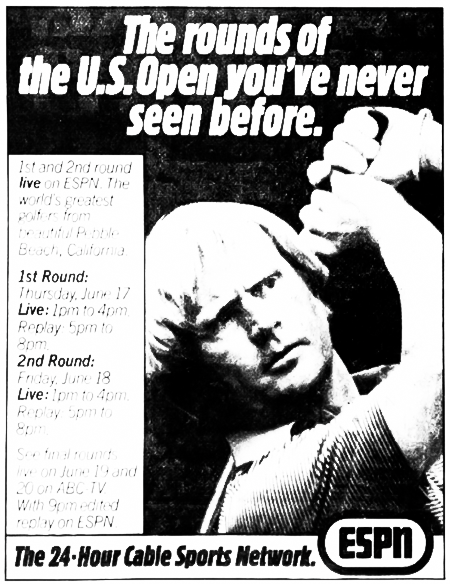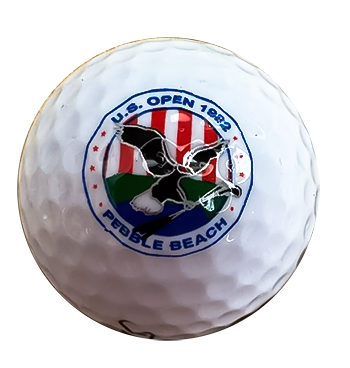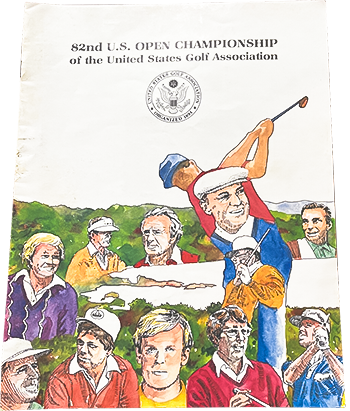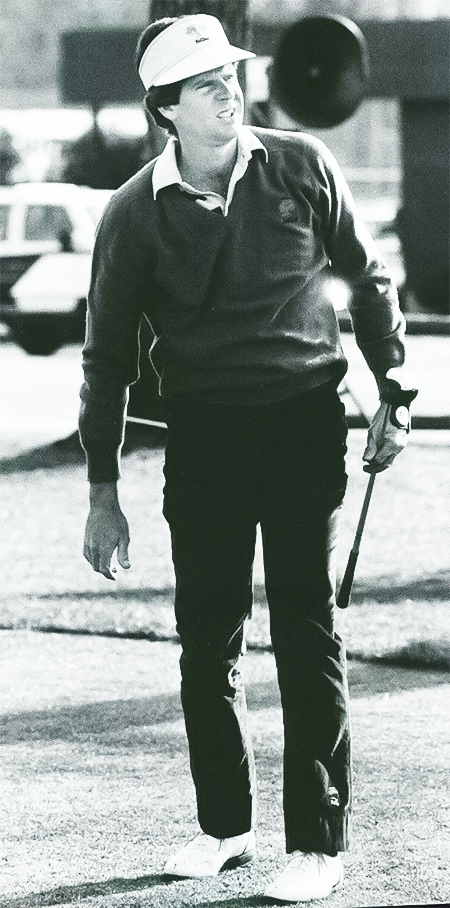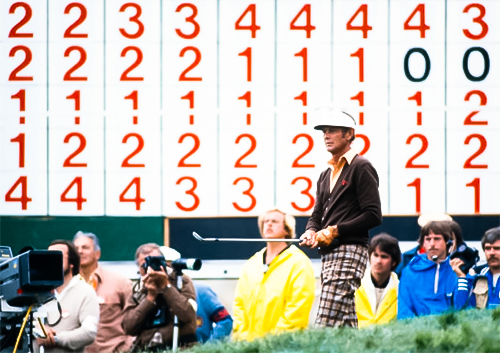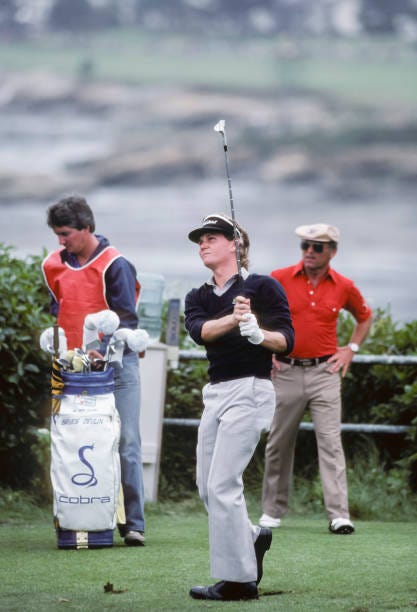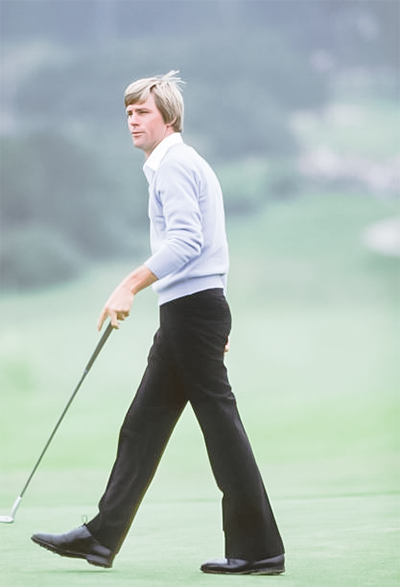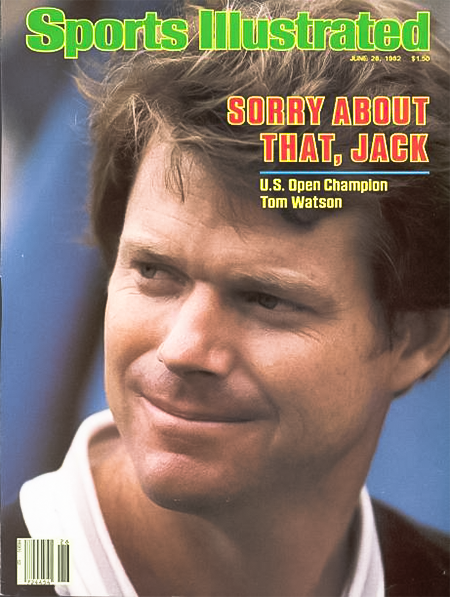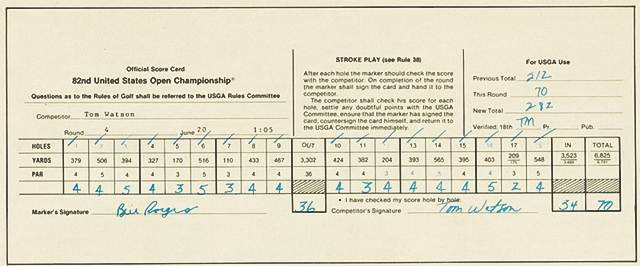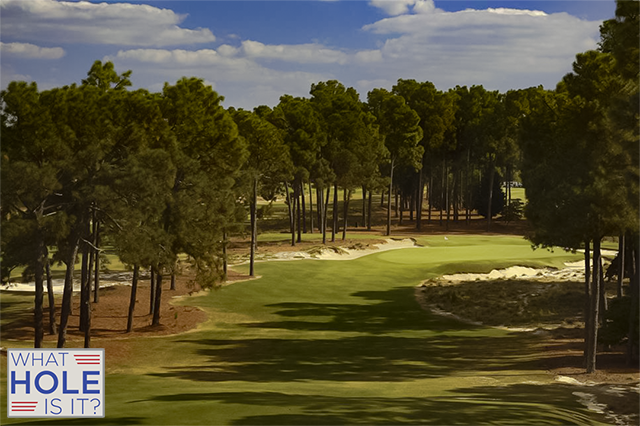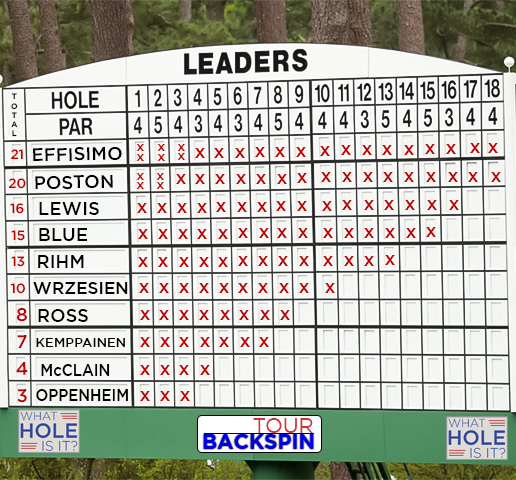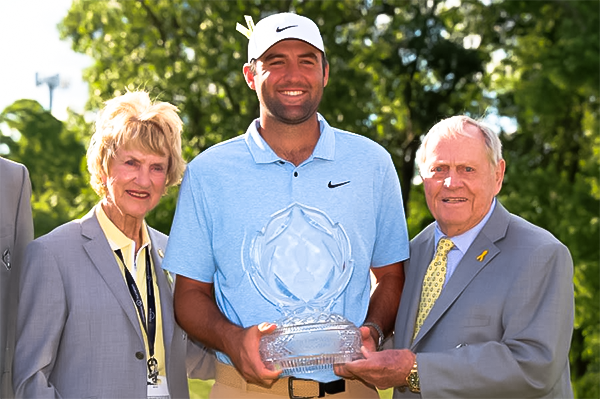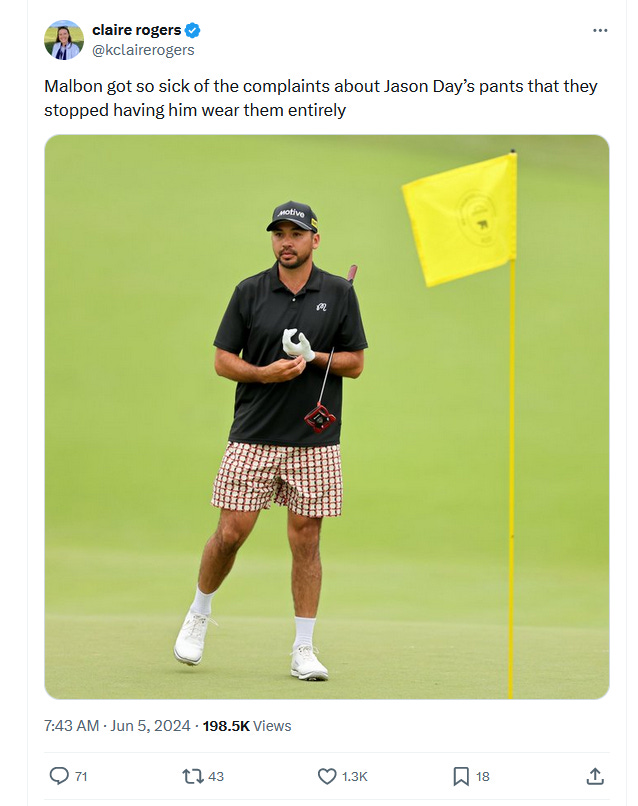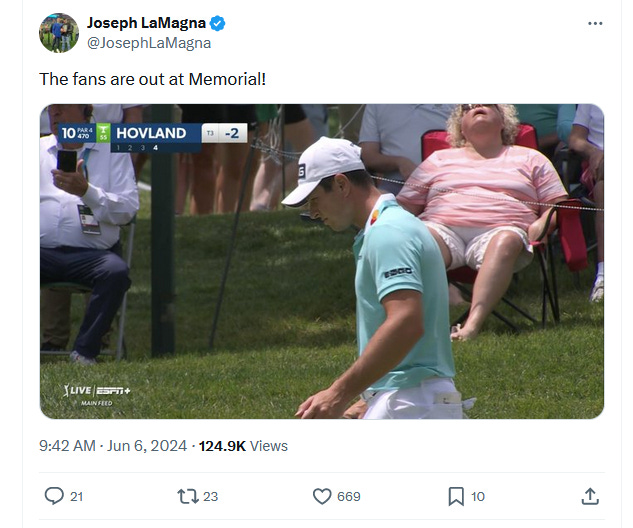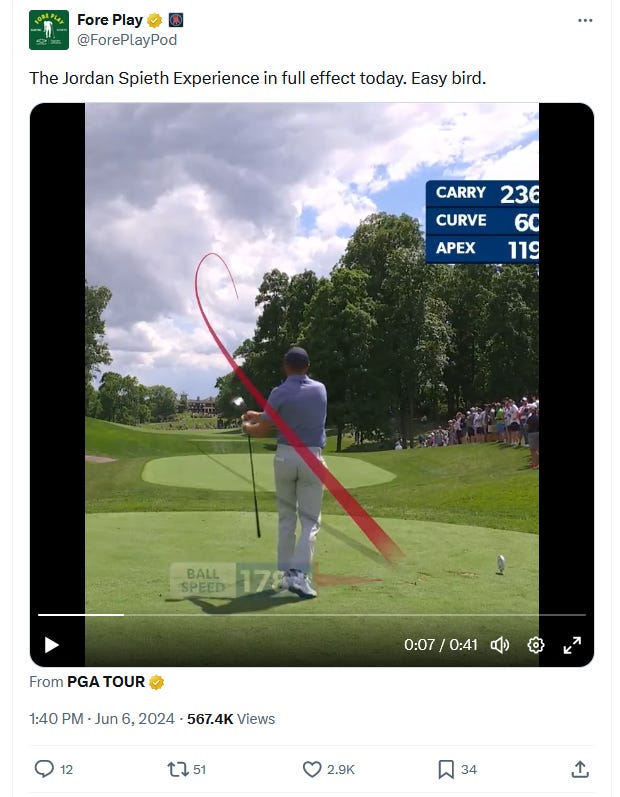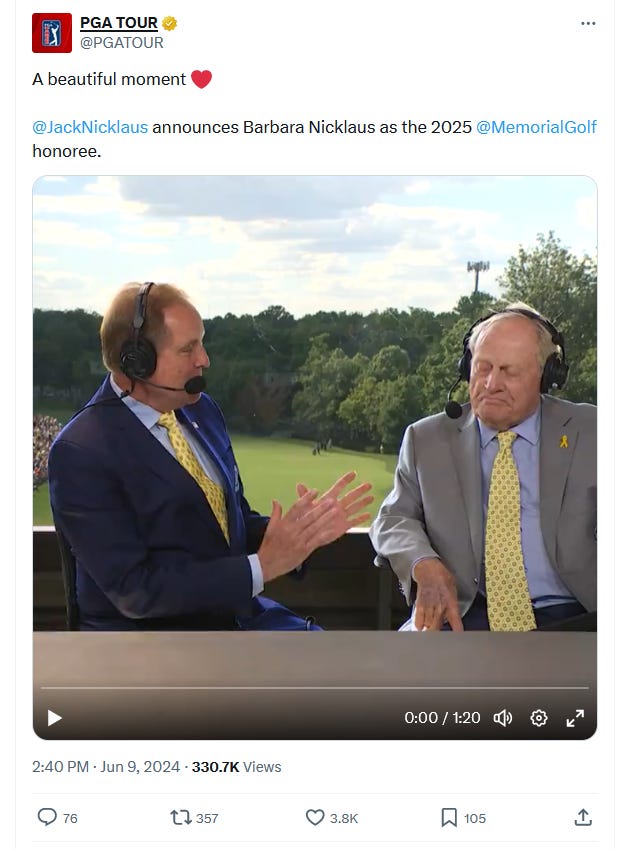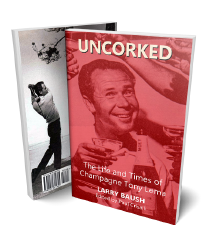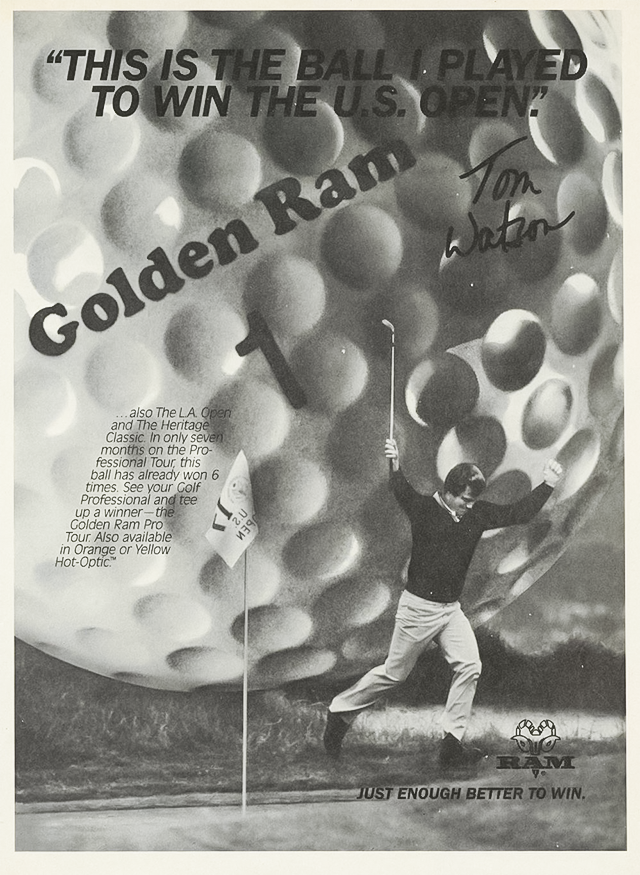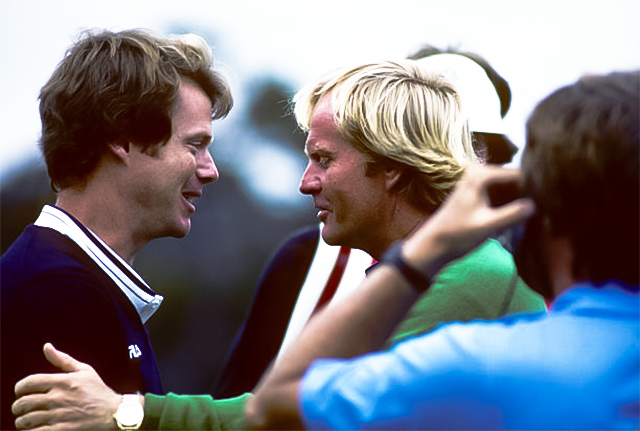
It’s a major week, and we’re going to take you onto the grounds of Pebble Beach for the 1982 U.S. Open. We take you inside the preparations for the tournament, inside the ropes, and inside the minds of both the winner, Tom Watson, and the low amateur, Nathaniel Crosby. Join us on our journey through the past as we time travel to the Monterey Peninsula in 1982 for one of the most exciting U.S. Opens in history. Get comfortable and pour yourself your favorite liquid refreshment. With so much going on that week, this is going to be a long one.
Enjoy watching the Open this week.
We wrote about the 1971 U.S. Open won by Lee Trevino, and the 1963 Open where Julius Boros won in a playoff, and the 1973 Open won by Johnny Miller with a Sunday 63.
He did it again. Scottie Scheffler won The Memorial Tournament, his fifth tour victory of the year. Scroll down for a tournament wrap-up, a few thoughts from me, and the Clips You Might Have Missed
We want to hear from you in the Tour Backspin Poll, and this week’s Music Clip goes back to 1982 and Tommy Tutone pleading for Jenny to call him. Watch Jack Nicklaus swing, with analysis by Ken Venturi, in this week’s Swing Like a Pro. Take a shot at this week’s WHAT HOLE IS IT? Presented by Rota Golf and you may just win a golf swag prize pack. Rota Golf has a cool way to map out your bucket list journey of playing the top 100 courses in the U.S. We’ve got some links for you in the Check it Out section and a Vintage Ad from Ram Golf cashing in on the miracle shot by Tom Watson in the 1982 U.S. Open. Scroll down to view.
We understand if you can’t pay for a premium subscription and we’re happy to have you here however you’ve arrived. You can sign up for a free subscription so you’ll never miss the newsletter. It will arrive in your inbox every Thursday.
In last week’s Tour Backspin Poll we asked you how much time do you take to warm-up before your round. Some folks, 17% of respondents, like me, need an hour or more to stretch, hit balls, and roll some putts. It was evenly split with 42% of respondents needing just 30 minutes and the same 42% rolling up to the 1st tee straight from the car.
There have been three U.S. Opens played at Pinehurst Resort, Course No. 2 since Payne Stewart won there in 1999 with a score of 279. Michael Campbell won in 2005 with a score of 280, and Marten Kaymer won in 2014 with a score of 271. That averages out to just over 276 for the winning score, so we ask you, will the winning score be over, or under, 276.5 this week at Pinehurst? Let us know in this week’s Tour Backspin Poll.
Tour Backspin Poll
Do you know what happened today in golf history? Or which famous golfer has a birthday today? Me, neither. But I do know where to go to find out. Check out the Your Golfer’s Almanac podcast. Host Michael Duranko celebrates birthdays, milestones, and other accomplishments that occurred on this day in golf history. Listen HERE.
We’re playing U.S. Open Hole-in-One Trivia in this week’s Tour Backspin Quiz. Scroll down to play.
Did you miss a previous newsletter? You can view it HERE. Help us grow Tour Backspin! Please forward this email to a friend. Was this newsletter forwarded to you? You can sign up HERE.
Okay, we're on the tee, let's get going.
Enjoy!
Larry Baush
“You Sonuvabitch. You’re Something Else.”
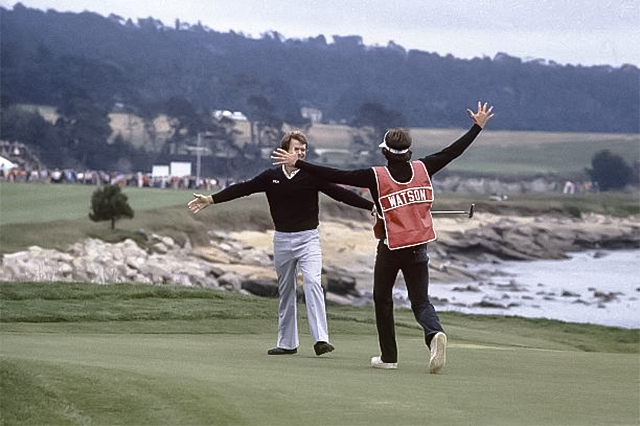
It is Wednesday, May 26th, 1982, and Ron Read, the western coordinator for the USGA, is hosting a couple of foursomes comprised of local sportswriters for a round of golf at Pebble Beach Golf Links. The outing provides a glimpse of the famous course as preparations for the 1982 U.S. Open have been progressing. The course is not quite ready, but it is close. While the greens are relatively slow and easily hold the shots from the sports scribes, the rough has been grown in to pinch in the landing areas in the fairways.
Mark Soltau of the San Francisco Examiner, who played to a three handicap, got off to a great start with a birdie on the first hole and an eagle at the second hole. Even though he cooled off during the round, Ed Vyeta of the Santa Cruz Sentinal assured his readers that Soltau was happy with the 79 he shot that day.
It was time, during the run-up to the start of the tournament, where pundits made predictions on who would win the 82nd U.S. Open. Vyeta, in the same Santa Cruz Sentinal column predicted that Tom Kite, with his accurate driving style, would win. David Graham, the defending champion, gave his predictions in the June issue of Golf Digest. He handicapped the field in an article with the headline, “I’m Picking Pate, But I’d Bet on Jack.”
If I had to pick a winner, I couldn’t put anybody in front of Jerry Pate. But if I were a betting man, especially if were my money, I’d bet on Jack Nicklaus.
He went on to write that if not for his Open record, it would be difficult not to pick Tom Watson as the favorite.
Here’s another man who loves Pebble Beach. As a student at Stanford he used to sneak out and play the course early in the morning, and he since has won two Crosby tournaments. His big problem is avoiding the one or two errant tee shots in every round that have always killed him in the Open.
Over at the rival Golf Magazine, it was Arnold Palmer who was doing the handicapping and authoring an article with the title “My Five Men To Watch.” He warned that he wouldn’t pick any one player to win, but that the winner would come from this group. His five men to watch included Tom Watson, Tom Kite, Bill Rogers, Raymond Floyd, and Jack Nicklaus.
Pebble Beach is the type of golf course that suits Tom Watson’s game. The course demands the kind of iron play and confident putting touch Watson possesses.
But Palmer also liked the chances of his old rival, Jack Nicklaus.
Jack Nicklaus gets the nod based on his awesome record both in the U.S. Open and at Pebble Beach. Nicklaus has won four Opens, the most recent at Baltusrol. One of the others—in 1972—was at Pebble Beach. Add to this the fact that he has won three Crosbys and the 1961 U.S. Amateur on this same layout. Also, keep in mind that he tied for third at the Crosby this year, and you get an idea of how much Nicklaus likes Pebble Beach.
ABC Television announced that it would televise all four rounds of the Open live for the first time in history. The network forged an agreement with the Entertainment and Sports Programing Network (ESPN) who would broadcast the Thursday and Friday rounds for three hours starting at 1 pm. ABC would then take over the broadcast on the weekend with four hours on Saturday, starting at 12:30 and Sunday starting at 1 pm.
Commentary during the first two rounds on ESPN would be provided by Jim Simpson, Lou Palmer, and Jim Thacker, while Frank Hanigan of the USGA, 1956 U.S. Open Champion Dr. Cary Middlecoff, and Golf Digest editor, Nick Seitz would provide analysis.
Jim McKay, Jack Whitaker, Peter Alliss, Dave Marr, Bob Rosburg, and Hanigan would provide the on-air commentary for ABC.
The U.S. Open office, located in the row of shops at the lodge at Pebble Beach, announced that there were still some tickets remaining for practice and tournament rounds, although one ticket package had been sold out. They added a warning that the fans should not wait past the first week of June to secure tickets. Daily tickets were available at Ticketron outlets around Northern California, as well as at Pebble Beach. Ticket prices for the practice round were $12, tournament rounds at $22 and a season ticket package cost $90.
Nathaniel Crosby, the reigning U.S. Amateur champion, and son of Bing Crosby, provided his insights to the tournament in an exclusive journal series for the San Francisco Examiner. On the Sunday before the start of the tournament he wrote about his expectations.
I’d really like to be low amateur in the tournament. My personal goal is to play as well as I can and shoot some numbers. If I think about being low amateur, it’s just going to make me uptight. It’s too easy to get hung up with the surroundings.
MONDAY
Gorgeous weather greeted players who checked in on Monday and, once on the course, they saw first-hand the condition of the course that had been groomed to U. S. Open standards by the USGA. Thick rough grown to between four and six inches framed the narrow fairways and the greens were running at nine on the Stimpmeter (a device that measures roll on the putting green) and were expected to run at 10.6 by Thursday.
“The greens are not in very good shape at all. They have a long way to go to get to Open greens.”
Tim Berg, director of golf at Pebble Beach, said, “The greens are harder and faster than at any other time.”
The greens were one area of concern back in February at the conclusion of the Bing Crosby National Pro-Am. Jack Nicklaus, Craig Stadler, and Jim Simmons, the winner of the Crosby, all voiced their apprehensions about the greens.
“They’re bumpy and not as good as I expected,” Nicklaus said back then.
Stadler agreed saying, “The greens are not in very good shape at all. They have a long way to go to get to Open greens.”
After the Monday practice rounds, players assured the press that the USGA succeeded in bringing the greens up to expected standards.
TUESDAY
Pebble Beach was blanketed in fog and mist during practice rounds on Tuesday morning before burning off shortly before noon. Huge crowds followed the favorites as they continued their preparations for the tournament. Nicklaus, Watson, leading money winner Craig Stadler, Johnny Miller, Hubert Green, Hale Irwin, and Raymond Floyd were all tagged as favorites to win.
“You won’t see any fluke winners here,” Irwin said to Mike Lopresti of the Gannett News Service.
WEDNESDAY
Charles Cooper, the sports editor for the San Francisco Examiner wrote that there were no clear-cut favorites in this U. S. Open. All the favorites, the contenders, and the dark horses, finished their preparations on Wednesday and were as ready as they could be for the first round on Thursday.
“That took some guts.”
Bruce Devlin made one final preparation on Wednesday while he was on the driving range. Unhappy with his driving, he decided to give a new metal driver a try late in the afternoon.
“That took some guts,” Devlin told Mark Soltau of the Examiner. “I never thought I would try one—that was the very first time I hit a metal wood. I’ve always been a traditionalist. I thought it was gimmicky. I don’t think I hit it any farther, but I do hit it straighter.”
Nathaniel Crosby wrote in his journal entry for the San Francisco Examiner that he felt his game was coming together nicely. He practiced at San Francisco Golf Club and Burlingame Country Club.
I’m pretty confident and feel good about the decision to stay away from Pebble Beach. I’m more relaxed at home and there’s no pressure. It was definitely the right move.
Crosby had a 9:11 tee time on Thursday morning playing alongside Bill Rogers, the reigning champion of the Open Championship, and David Graham, the defending U.S. Open champion. Nicklaus was off at 9:54 playing with Andy North and Tom Weiskopf. Tom Watson and Craig Stadler were playing together along with Larry Nelson at 2:23.
THURSDAY
Danny Edwards, who celebrated his 31st birthday on Monday, teed off at 8:28 in the opening round. The day started with a slight mist that gave way to occasional sunshine, but the weather was cool and sometimes windy. Edwards got off to a hot start with a birdie on the first hole and then chipped in for an eagle on the second hole. With a birdie on the fourth and another on the sixth, Edwards finished the front nine with a five-under-par 31.
Edwards got it to six-under after 13 holes, but then the wheels came off for the part-time auto racer. He double-bogeyed the par-5 14th hole, followed that up with a bogey on the 16th and another double-bogey on the 17th hole. A par at the final hole gave him a score of 40 on the back nine for a total of 71.
“I had a couple of blowouts on the last nine holes,” Edwards joked to Ed Vyeta of the Santa Cruz Sentinal. “I just feel like I want to go home, change tires, and come back tomorrow.
Bruce Devlin, who now split his time between playing the tour part-time and being the on-air analyst for NBC coverage of the tour, found some of the old magic in the first round. It didn’t look too magical when he bogeyed the par-5 sixth hole and then followed with a double-bogey at the short seventh hole. But then he was able to get it together and played the back nine in two-under-par and was able to post a 70. Devlin had to go through qualifying to get into the Open and his last win on the tour came in 1972.
“I have been under scrutiny—both myself and my game. I probably pressed more than I should have. This may be the week that I do come out of it.”
Bill Rogers, the winner of the 1981 Open Championship and the PGA Player of the Year, had not followed up his major win with success in 1982. He admitted that winning a major had put some added pressure on him.
“I have been under scrutiny—both myself and my game,” he told Vyeta. “I probably pressed more than I should have. This may be the week that I do come out of it.”
Rogers birdied three of his first six holes but then ran into trouble on the seventh hole where he missed the green and then again at the eighth when he three-putted. He was able to claw one stroke back with a birdie at the ninth hole after hitting a 1-iron approach shot to inside of eight feet and made the putt. He then finished the back nine steadily playing it in even par for a 70 and share of the lead with Devlin.
Jim King, an unknown club pro from Miami, shot a 71 and was tied with Edwards, Calvin Peete, Terry Diehl, and Bobby Clampett, who was a fan favorite as he was from Carmel. Andy North led a group of nine players who were tied at 72, including Tom Watson and George Burns. Nicklaus opened with a 74, while defending champion David Graham had a 73.
Nathaniel Crosby started his U.S. Open with a 77 while Hubert Green, Raymond Floyd, Andy Bean, Lee Trevino, Johnny Miller, and Gary Player all had disappointing 78s. Jerry Pate was one stroke worse at 79.
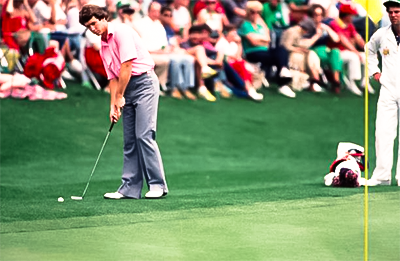
Despite the opening round 77, Nathaniel Crosby was not totally discouraged as he wrote about in his journal entry for the San Francisco Examiner.
That was a bummer. I feel very good about going out tomorrow. My confidence isn’t shaken. I think I’ll be in very shape tomorrow. I’ll be aggressive.
The winds that buffeted the course, with gusts up to 36 mph, especially in the afternoon, kept scores high. No player who teed off after 1 pm was able to break par, and only a couple, including Watson, were able to match par.
After one complete round, it was clear that Pebble Beach would be putting up a difficult test that was up to U.S. Open standards.
FRIDAY
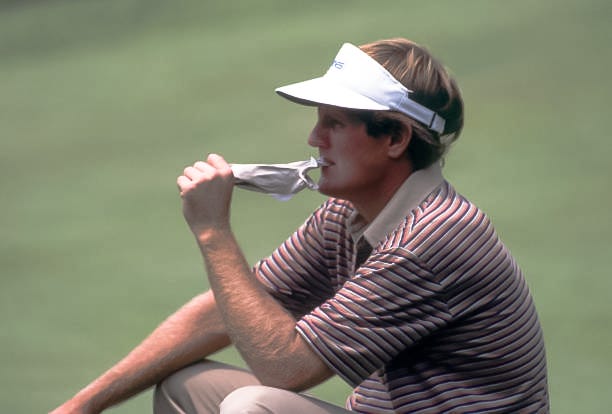
George Burns, who finished runner-up at the 1981 U.S. Open, came out on Friday morning and grabbed the tournament by the throat. After a par on the opening hole, Burns went on binge of birdies with six straight on his way to setting a U.S. Open record for most consecutive birdies and tied the record score of 30 for nine holes. With his birdie at the seventh hole he pulled into a tie, at six-under, for the lead with Devlin.
“When I tried to hit it, I drove it deeper into the bank. I should have taken a drop.”
Devlin bogeyed the 9th hole and Burns found himself alone at the top of the leaderboard. Burns could not keep up the pace on the back nine and he bogeyed the 10th, 12th, and 15th holes. Then disaster struck. He hooked his 1-iron at the par-3 17th hole into long grass at the edge of the cliff overlooking the Pacific Ocean.
“When I tried to hit it,” Burns related after his round, “I drove it deeper into the bank. I should have taken a drop.”
He ended up with a triple-bogey on the 209-yard, par-3 and signed his card for a score of 72 with a back nine 42.
“I don’t think you ever get used to something like this,” he said. “I’m disappointed with my 42, then again, if I shoot anywhere around par the next two days, I’ll be close.”
Devlin birdied the 2nd, 3rd, 4th, and 7th holes to get to six-under before his bogey on the 9th hole. He added bogeys at the 10th, 11th, and 13th holes to bring him back to the field. He was able to regroup and birdied three of the final four holes. At the par-5 finisher, he hit a sand wedge for his third shot. The ball took two bounces, hopped into the cup, and just as quickly, hopped right back out. He made the four-footer for his birdie and a round of 69 for a two-day total of 139, and the lead.
Larry Rinker, who hadn’t made a cut since April, shocked all observers when he posted the round of the day, a five-under-par 67 that gave him a total of 141.
“I haven’t made a cut since New Orleans (April 22-25),” Rinker said after his round. “I was just trying to play a good round. I saw Devlin was five-under and I tried to catch him.”
For his part, Devlin was happy with his play and his chances for the rest of the tournament saying, “I’ve played beautifully for two days. I don’t see any reason why I shouldn’t continue to play well. If the wheels come off, I’ll just have to hang in there and see what I can do.”
Scott Simpson scored a 69 in the second-round and trailed Devlin by two shots while Lyn Lott was another stroke back at 143 after a second-round 71. He was tied with Calvin Peete (71-72), Bill Rogers (70-73), and Andy North (72-71). Tom Kite was at 144 after shooting 71 in the second-round and he was tied with Tom Watson (72-72), George Burns (72-72), Jack Nicklaus (74-70), and Bobby Clampett (71-73).
“I’m obviously in pretty decent position and I’m playing well. If I play two more good rounds of golf, I’ll have a good chance to win the tournament.”
Nicklaus felt good about his chances in the final two rounds.
“I could have shot a very good number today if I had been a little warmer with my putter,” he said after his round. “I’m obviously in pretty decent position and I’m playing well. If I play two more good rounds of golf, I’ll have a good chance to win the tournament.”
“I shot a 77, but I scored a 72.”
For Nicklaus, “two more good rounds of golf” meant shooting under par for both rounds of the weekend.
Tom Watson had to scramble for his 72 as he only hit five fairways.
“I shot a 77, but I scored a 72,” is how he viewed his round.
“The course is defenseless now,” he declared describing his round as, “A very sloppy round of golf. I was looking for something better than a 72.”
Despite a disastrous 14th hole, Nathaniel Crosby was able to gut out a second-round 73 for a two-day total of 150 and made the cut. He poured out his feelings in his journal entry for the Examiner.
The 14th hole was like the recurrence of the Pompeii destruction. It was the destruction of Nathaniel. I hit a bad drive, a near whiff, two no-brainers, and some shenanigans around the green resulted in a nine. I was thinking how nice it would be to have a nice, stiff drink.”
But there would be no stiff drinks in his near future. Not with an 8:41 tee time in the third round teeing off as the low amateur in the U.S. Open.
There were 64 pros, and two amateurs, Crosby and Corey Pavin, who made the cut, which came at 151.
SATURDAY
Pebble Beach was shrouded by dark gray clouds that occasionally leaked cold drizzly rain on Saturday for the third round. Players donned sweaters to ward off the cool temperatures, but on the bright side, there was little wind for them to contend with.
Saturday, known as “moving day,” lived up to its moniker as the leaderboard was in constant flux with names moving up into contention only to fall back. There were plenty of players to get involved with the jockeying as 11 players were within five shots of Devlin’s lead at 139.
The defending champion, David Graham, started the day six strokes off Devlin’s lead. He got off to a slow start with a bogey at the 170-yard, par-3, 3rd hole, and it looked like he would add another at the 5th hole.
“I didn’t hit a good tee shot,” he explained after the round. “But I chipped seven or eight feet and putted for par. That was a turn-around because I birdied the next two holes.”
Despite a couple of poor club-selection decisions, Graham played the final 13 holes in five-under-par and posted a 69 for a total of 214. Playing behind Graham, players continued to battle as they fought their way up the leaderboard. It was a day-long battle that saw seven different players sharing the lead at one time or another.
“I figured you guys would be through with me.”
Devlin bogeyed three of his first ten holes and never scored a birdie all day and shot a 75 surrendering his two-shot lead.
“I figured you guys would be through with me,” Devlin remarked to the press after his round. “I played awful. I suppose there is some consolation, being just two shots back. I got away with murder today—just played awful golf, struggling all the way. Playing the way I did, I probably should have blown myself out of the tournament—but I’m not.”
“A 71 is not that bad of a round to shoot, but I have to shoot better tomorrow to win.”
Nicklaus accomplished the first leg of his weekend goal of shooting two rounds under par. He recorded a 71 in the third round for a total of 215 but he knew he would have to play better if he was going to win his fifth U.S. Open Championship.
“A 71 is not that bad of a round to shoot,” he said after the round. “But I have to shoot better tomorrow to win. I don’t think the position I’m in is bad. Anybody even with par has a chance to win.”
“We could have a real good finish. You’ve got some good names on the leaderboard.”
Nicklaus had birdies at the 2nd and 10th holes and a bogey at the 12th. If he had any reason for disappointment, it would be that he failed to cash-in on numerous birdie opportunities ranging from five to 18 feet.
“We could have a real good finish,” Nicklaus predicted. “You’ve got some good names on the leaderboard.”
One of those names was Tom Watson, and he agreed with Nicklaus about the crowded leaderboard.
“There are a lot of players who can win tomorrow,” Watson said. "All they have to do is go out and shoot a 69.”
“Obviously, I like the position that I’m in. I had a good feeling about my golf swing today and I feel good going into tomorrow’s round.”
Watson carded a 68 in the third round for a total of 212 and sat atop the leaderboard. He secured birdies on the 3rd, 4th, 7th, 8th, 12th, 16th, and 18th holes offset by three bogeys.
“Obviously, I like the position that I’m in,” he said. “I had a good feeling about my golf swing today and I feel good going into tomorrow’s round.”
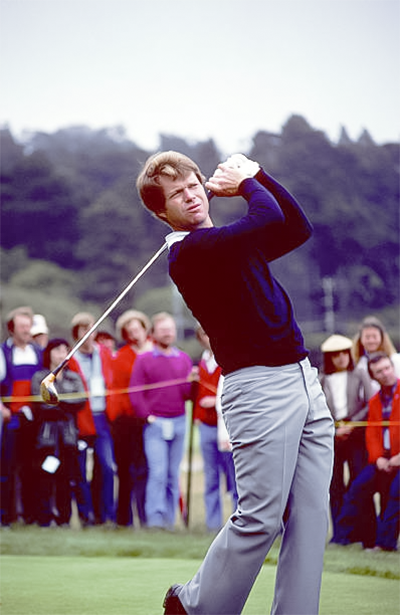
He then got philosophical about his desire to win a U.S. Open, a tournament he had never won.
“The Open is very important to me,” he said. "This (Pebble Beach) would be a great place for me to win it, but any place would be great. I’ll take one anywhere. The Open is the most important tournament that I haven’t won.”
The other name atop the leaderboard after the third round was Bill Rogers, winner of the British Open in 1981. He shot a three-under-par 69 and was tied with Watson at 212. He also agreed with Nicklaus and Watson about the quality of the players in contention.
“Anybody within five shots still has a chance,” he insisted after his round.
He had birdies at the 2nd, 4th, 6th, 14th, and 15th holes and bogeys at the 10th and 17th holes.
“I’m happy with it, after the round I had yesterday,” Rogers said about his round. “I can’t pretend that I felt too good coming out today after yesterday. But that’s what the U.S. Open atmosphere does for you. It keeps you hanging in there. That’s what I did yesterday, and it paid off today. I’ve got to be confident tomorrow.”
So, the leaderboard was set, and it promised to be an exciting final round. The other players within five shots of the leaders included George Burns, and Scott Simpson at 214, Calvin Peete was tied with Nicklaus at 215, Lanny Wadkins, Dan Pohl, Craig Stadler, Bobby Clampett, and Larry Rinker were at 216, and at 217 were Lon Hinkle, and Jim Thorpe.
Nathaniel Crosby still hung on to his position as low amateur after shooting a 76 for a three-round total of 226. He was three shots in front of Corey Pavin. He wrote about his strategy for Sunday in the journal he was keeping for the San Francisco Examiner.
My goal for Sunday is to play my best golf—I didn’t do that today. I’m going to hit a few balls because I didn’t like the way I hit my driver coming in.
The attendance for the day was announced at 16,500, bringing the three-day total to 45,500. Those fans enjoyed Olympia beer for $1.75, or an imported Heineken for $2.50. Well drinks cost $3 but if you called your shot, it would cost you $3.25, except for a Jack Daniels that went for $3.50.
Late on Saturday, P.J. Boatwright, Jr., and Jim Hand, officials with the USGA, directed the pin placements for Sunday’s final round. True to the tradition of final round U.S. Open pin placements, they found the most challenging locations, including the one at the par-3, 17th hole where the pin was tucked against the left side of the green, just five or six paces from the heavy rough that protected the green.
SUNDAY
“He was more relaxed than ever.”
Tom Watson prepared for the final round of the tournament he most wanted to win at that point in his career by staying up and watching television until 11:30 p.m. on Saturday night. He awoke on Sunday and fixed his own breakfast by pouring himself a bowl of cereal. He later admitted that he was nervous, but he tried to calm his nerves by reading the newspaper. He read the front page and the financial page, but not the sports page.
It must have helped because his wife, Linda, told Kevin Woodward, sportswriter for the Santa Cruz Sentinel, “He was more relaxed than ever.”
“I’m playing as well as I’ve ever played in an Open.”
Bobby Wadkins and Doug Tewell were the first twosome off on a windless, but cool and overcast Sunday morning and both players were well out of contention. They determined to get their round over quickly and played in two hours and 11 minutes. Wadkins shot a 75 for a 304 total while Tewell triple-bogeyed the final hole for a round of 90.
Through the first three rounds, Nicklaus made just six birdies. He still felt confident about his chances saying, “I’m playing as well as I’ve ever played in an Open.”
He would double the number of birdies he made by the time the day ended. He made five straight birdies starting at the 3rd hole placing him right in the thick of things.
As he waited to start his round, Watson knew he had a chance to win the tournament. The fact that he had played the more difficult holes of the back nine well gave him a confident feeling. He told his caddie, Bruce Edwards, to just keep reminding him to keep his tempo smooth.
Watson birdied the 2nd hole to take sole possession of the lead but then handed it right back with a bogey at the 3rd hole resulting in a four-way tie for the lead. Devlin, Nicklaus, and Watson’s playing partner, Bill Rogers shared the top spot with Watson.
Nicklaus, Rogers, and Devlin then birdied their way into a three-way tie for the lead. Devlin and Nicklaus then promptly bogeyed the next hole leaving Rogers with the sole possession of the lead. He held that lead, at five-under-par, for five holes before he bogeyed the 9th hole. He and Watson were now tied for the lead as Nicklaus three-putt the 11th hole for a bogey.
Rogers added another bogey at the 10th hole, a hole that also proved pivotable to Watson who hit his 7-iron approach shot short and right of the green, down the side of a cliff. From there he was able to hit a sand wedge from the kikuyu grass to about 25 feet from the hole, on the fringe of the green. Using a putter, he saved his par running in the 25-footer. He later wrote about the putt in the February 1983 issue of Golf Digest.
The putt looks as though it breaks right, but I knew from past experience in past tournaments at Pebble Beach that it’s dead straight. I played a straight putt, and it went straight in. Finally—my first really good putt of the day! My putter was warming up at last.
He now held the lead all to himself. He had been hitting his driver well for most of the week and was driving it “farther than I ever have driven in an Open—averaging nearly 300-yards off the tee.” On the 11th hole, he boomed a drive down the right side of the fairway leaving himself only a pitching wedge into the green. He hit his approach to 22-feet and faced a putt that had a large left to right break. He stroked this into the hole for another birdie and a two-stroke lead.

He pushed his shot at the par-3, 12th hole, a 204-yard beast with a green that is extremely difficult to hold, into the right greenside bunker. From there he hit a poor sand shot resulting in a bogey that left him two shots in front of Rogers, and one shot in front of Nicklaus. Bruce Edwards reminded him to keep his tempo smooth.
While Watson was securing a par on the 13th hole, Nicklaus was birdieing the 15th hole, and the two men were tied. Watson could feel his adrenaline coursing through his body.
On the 14th hole, a 565-yard, par-5, that doglegs sharply to the right, Watson hit another long drive, but did not even consider going for the green in two. There was too much trouble up around the green and the wiser play was to layup. He hit a 5-iron that left him just under 100-yards, but in a bad, thin, lie with the ball above his feet. He hit the shot thin, so thin that he cut the cover of the ball, but wound up on the green, 35-feet from the cut. After consulting with Edwards on the read of the putt, he stroked the difficult putt with perfect speed, and it dropped into the cup for another birdie. He felt the pressure lift from him as he watched the ball disappear into the hole.
And for the first time that day, the pressure wasn’t pushing me. It simply left, and I felt a great inner calm. I knew what I was trying to do and was doing it, and I was enjoying myself for the first time in the round. I’ve been in that mental state a few times, and it’s the greatest feeling you can have in golf.
Watson then missed the only fairway he would that day at the 16th hole ending up in a new fairway bunker that was added to the hole by the USGA for this tournament. He had to hit sideways out of the deep bunker to get to the fairway. From there, he hit a poor wedge shot that left him a 50-foot putt for par. He was fortunate to two-putt from there for a bogey.
“There’s only two of us left.”
Nicklaus had been following the ups, and downs, of Watson’s round and as he walked to the 17th tee, he stopped to study the leaderboard and then turned to his oldest son, Jack Nicklaus, Jr., who was his caddie.
“There’s only two of us left,” he said.
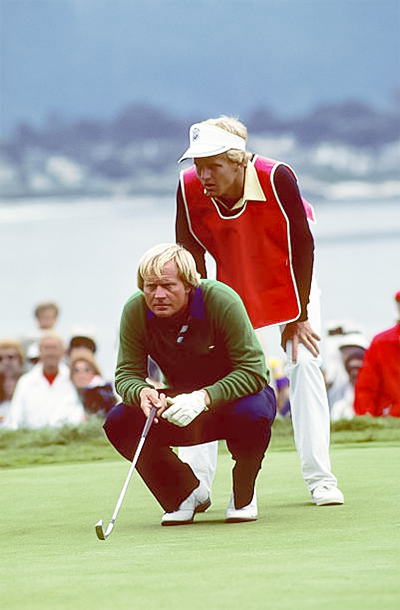
He was correct as Rogers’ putter deserted him, especially on birdie putts on the 16th and 17th holes. Dan Pohl mounted a sneaky, late, charge but it was too little, too late. Nicklaus secured a par at the treacherous 17th hole and parred the final hole for a round of 69 and a total of 284. He then went over to the scorer’s tent and watched Watson’s tee shot at the 17th hole. He watched as Watson drew his shot too much. The shot went left of the difficult pin placement and the ball dived into the long rough.
“Uh-oh, now I’m dead.”
“He’s going to have to birdie 18 to catch me,” Nicklaus said after seeing the shot. “There’s no way he could get up and down from there.”

Nicklaus looked away from the television monitor, missing the chip shot that Watson was about to play.
Watson watched his ball dive into the rough and thought to himself, “Uh-oh, now I’m dead.” He faced a downhill lie to a downhill sloping green. Walking to the green he felt he was going to have to make a long par putt. But once he got to his ball and saw his lie, his feelings changed about the shot. The ball rested in a good lie, one where he would be able to slide the leading edge of his sand wedge under the ball.
He pulled the Wilson Dyna-Powered “Fluid Feel” sand wedge from his bag. He wrote in Golf Digest what happened next.
I walked over to Bruce (Edwards), and he was choking. He mumbled something about how I could get the ball close, and I said, “I’m not going to get the ball close—I’m going to sink it.” Right there and then, I honestly believed I was going to hole the shot.
He then took a couple of practice swings, opened the face of his sand wedge, and took the club back with a little extra cock to the right hand. He hit the ball with a little cut swing under the ball which popped up very high and softly landed just on the putting surface. The ball took two bounces and then started to roll like a putt and broke to the right.
“I told you!”
As it tracked towards the hole, Watson moved to his left to get a better view. When the ball was a foot from the hole, he knew it was in and that he had a one-stroke lead in the U.S. Open. He ran in a kind of dance down the green and past the hole before turning towards Edwards, pointed at him, and roared, “I told you!”
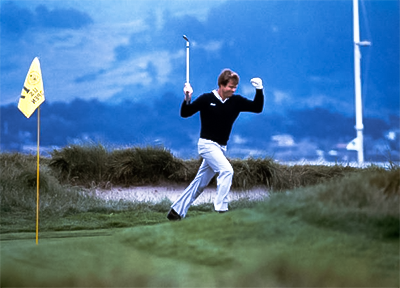
Nicklaus heard the roar from the crowd at the 17th hole and turned his attention back to the television just in time to see Watson’s celebration.
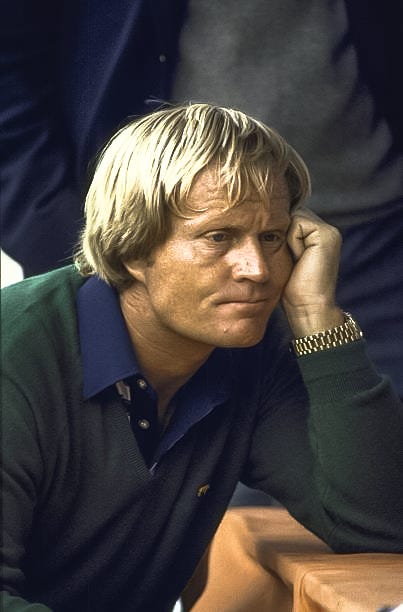
“I saw him hit the first one and didn’t see him hit the chip shot,” Nicklaus said to reporters later. “But I saw him running around. I thought, ‘He must have lipped it out.’ I can’t believe anyone could have holed it.”
Watson played it safe on the final hole and was rewarded with an unnecessary birdie at the final hole to finally add a U.S. Open title to his resume. Nicklaus walked from the scorer’s tent towards the 18th green where he held his hand out to congratulate Watson.
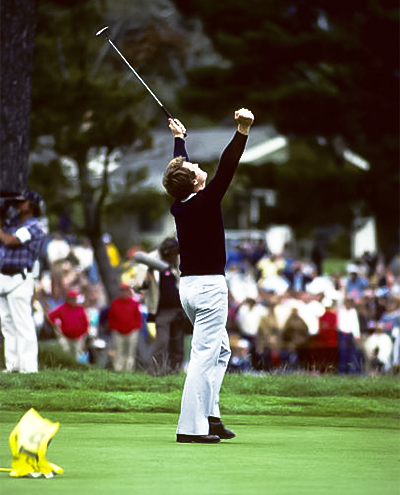
“You sonuvabitch. You’re something else,” Nicklaus said as the two shook hands. “Nice going, I’m really proud of you.”
Nicklaus was asked in the press tent by a reporter if there was one shot he could play over, which shot would it be.
“Watson’s at 17,” was his quick response.
Watson won $60,000 for the win bringing his 1982 earnings to $288,796. Nicklaus won $34,506 for his solo second-place finish. Bobby Clampett, Dan Pohl, and Bill Rodgers won $14,967 for finishing in a tie for third place at 286, four strokes behind Watson. David Graham finished at 287, tied with Lanny Wadkins, Jay Haas, and Gary Koch and collected $8,011 each. Bruce Devlin finished at 288, tied with Calvin Peete and won $6,332.
Nathaniel Crosby shot a final round 77 for a four-round total of 303 and captured the low amateur title over Corey Pavin, by one-stroke. He did his final journal entry for the San Francisco Examiner.
I don’t care what other people think. I know I can play when I prepare myself properly. A lot of people said I was lucky to win the U.S. Amateur. I played well in the Amateur and now the U.S. Open. It’s a positive reinforcement for me. I think this will relieve some pressure and gain some respect from my peers. In the past, I haven’t played well with the big boys.
After beating Nicklaus in the Masters in 1977, then again at Turnberry in Scotland for the Open Championship the same year, Watson added a third time of beating Nicklaus in a major with his win at the 1982 U.S. Open. He did it with a miraculous chip shot on the 17th hole at an iconic golf course he used to sneak onto when he was a student at Stanford.
Follow us on Facebook, Instagram, Twitter, YouTube and Threads.
BONUS STORY
Tom Weiskopf aced the 7th hole in Sunday’s final round with a pitching wedge. It was the third hole-in-won of the tournament, a U.S. Open record. The other aces were scored by Bill Brodell on Friday with a 6-iron on the 5th hole, and Johnny Miller, also on Friday, at the 12th hole using a 3-iron.
Weiskopf almost made a second ace on Sunday when his tee shot on the 17th hole landed three inches from the cup.
Weiskopf was the individual leader in Open aces as he also made one at the 1978 U.S. Open at Cherry Hills.
Before Friday’s aces, the most recent hole-in-one was recorded by Tom Watson in the 1980 U.S Open at Baltusrol.
What Hole is It? powered by Rota Golf. Doesn’t your bucket list journey deserve one of these?
WHAT HOLE IS IT?
Are you on the leader board?
Congratulations to Doug Poston who correctly identified #4 at Muirfield Village in Dublin, OH, in last week’s WHAT HOLE IS IT? contest. Doug beat out three other correct answers in the random drawing. We’re sending a prize pack to Doug. Submit your answer for this week and get yourself into the race for the Herbert C. Leeds Trophy, our new perpetual trophy for the annual winner.
PGA TOUR Wrap-Up | The Memorial Tournament
Despite a final round of two-over-par 74, Scottie Scheffler won his fifth tournament of the year capturing The Memorial Tournament. He has won at Arnold Palmer’s Bay Hill, Bobby Jones’ Augusta National, Harbour Town Golf Links designed by Pete Dye and Jack Nicklaus, and TPC Sawgrass, designed by Pete Dye, and now The Memorial at Jack’s Muirfield Village. That’s a Mount Rushmore of course designers.
Scheffler took a four-stroke lead into the final round and was able to hold off Collin Morikawa who shot a final round 71. Morikawa was the only player from the final 13 groups to break par garnering him his fifth top-5 finish of the year.
Scheffler is the first player since 1962 to head into the U.S. Open with 5+ PGA TOUR wins, including a major, for the season. The guy that did it in 1962? Arnold Palmer.
Read the tournament recap by Adam Schupak of Golfweek USA Today HERE.
Clips You Might Have Missed
I know that players can wear shorts during practice rounds, but bathing suits?
I hate it when this happens.
Love the stories from U.S. Open qualifying.
Jordan doing what Jordan does.
This is so sweet.
Are you ready for this at Pinehurst?
Here’s every hole at Pinehurst #2.
Tour Backspin Quiz | U.S. Open Hole-In-One Trivia
When was the record of three holes-in-one set at the 1982 U.S. Open at Pebble Beach broken?
Scroll down for answer
Swing Like a Pro
Jack Nicklaus golf swing with analysis by Ken Venturi
Blind Shot
Click for something fun. 👀
Tour Backspin Music Clip
Jenny, Jenny, who can I turn to? Jenny 8675309 by Tommy Tutone from 1982.
Uncorked, The Life and Times of Champagne Tony Lema tells the story of one of the tour’s biggest stars in the mid-1960s. A fascinating glimpse into the traveling caravan that was the PGA TOUR during an era where the fields were full of “Mad Men” era personalities. From a hardscrabble youth spent on the “wrong side of the tracks” in the Oakland suburb of San Leandro, to the temptations of Elko, Nevada, to the bright lights of the PGA TOUR, Uncorked tells a story of determination, redemption and, above all else, a love story that documents how Betty, Tony’s new wife, provided the direction and motivation for him to become a top star. Order on Amazon.
CLOSE COVER BEFORE STRIKING
Tour Backspin Quiz Answer:
The record of three holes-in-one at the 1982 U.S. Open, made by Johnny Miller, Tom Weiskopf, and Bill Brodell, was broken in 1989 when there were four holes-in-one made at Oak Hill Country Club, by Doug Weaver, Mark Wiebe, Jerry Pate, and Nick Price. The record of three was tied in 2022 when Shigeki Maruyama, Andy Miller, and Scott Hock made aces, and in 2023 when Matt Fitzpatrick, Sam Burns, and Matthieu Pavon duplicated the feat.
Tom Weiskopf still holds the individual record with two aces in a U.S. Open (1978 and 1982).
Thank you for reading this far, I know your time is valuable and choosing to spend some of it on what I’ve created is gratifying. If you want to help support the work we’re doing, please consider upgrading. It’s just $36 a year and you’ll be helping to tell the stories from one of golf’s golden ages.
Vintage Ad
Final Thoughts
How cool is Pebble Beach? Can’t wait for the Open to return in 2027.
Will we see the hole-in-one record in a U.S. Open broken this year?
Wild that 1982 was the first-time that Thursday and Friday rounds at the U.S. Open were broadcast.
Good news! Rory and his wife, Erica, cancelled their divorce.





